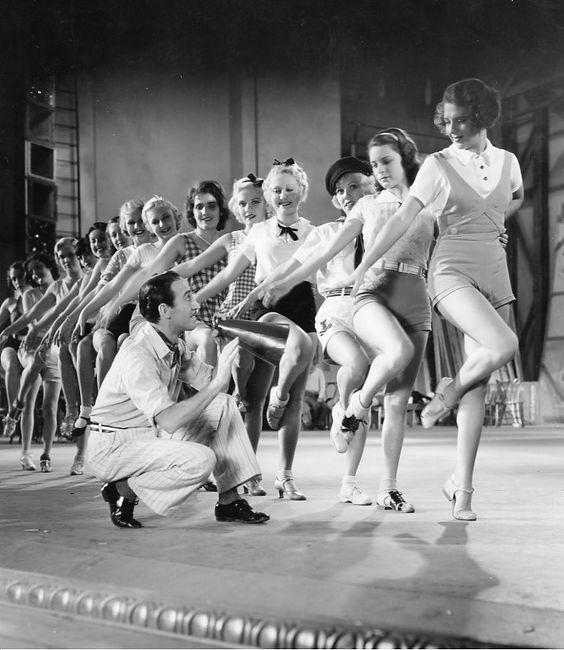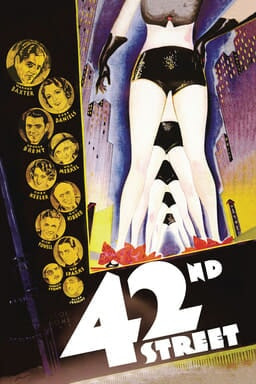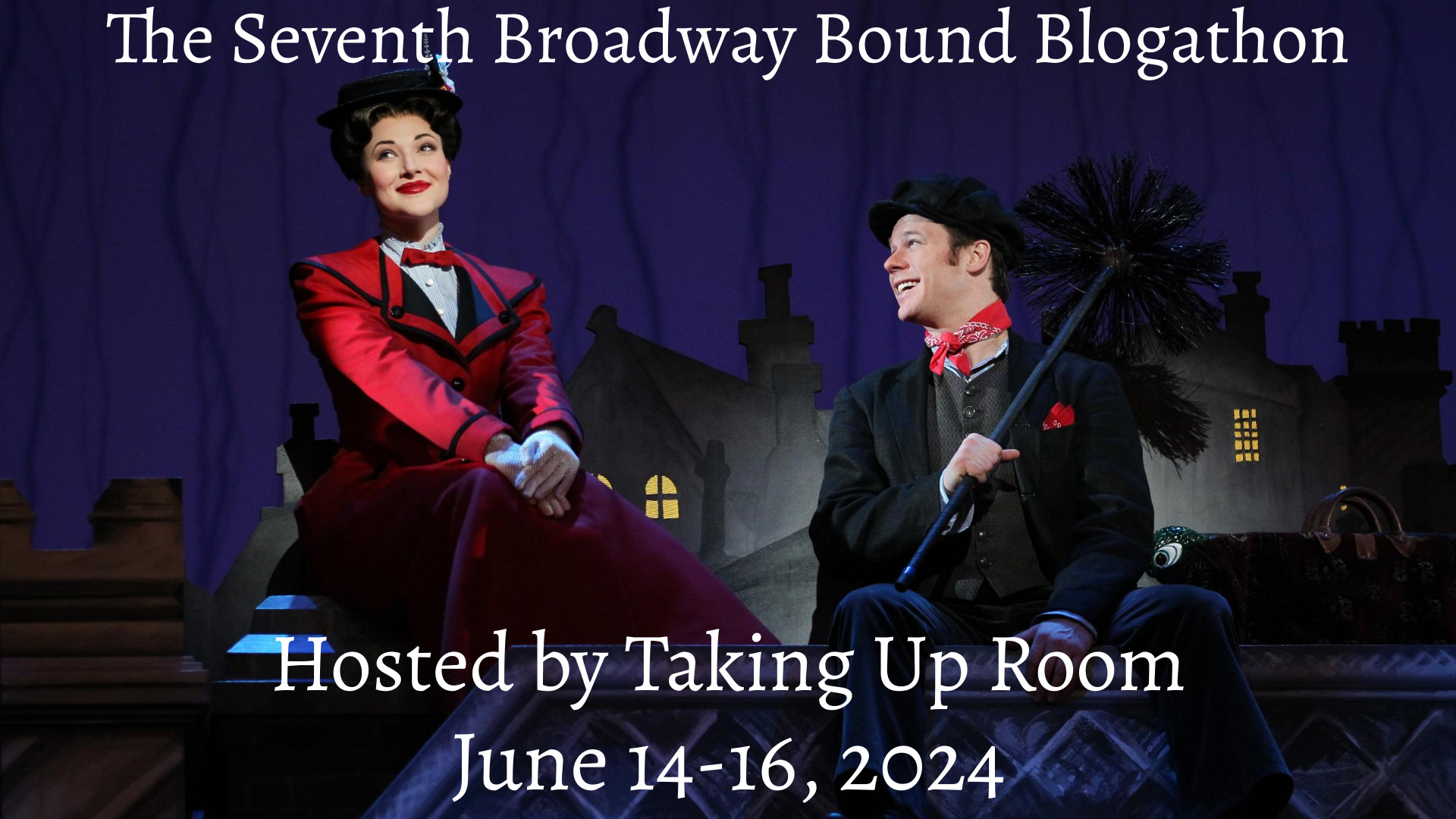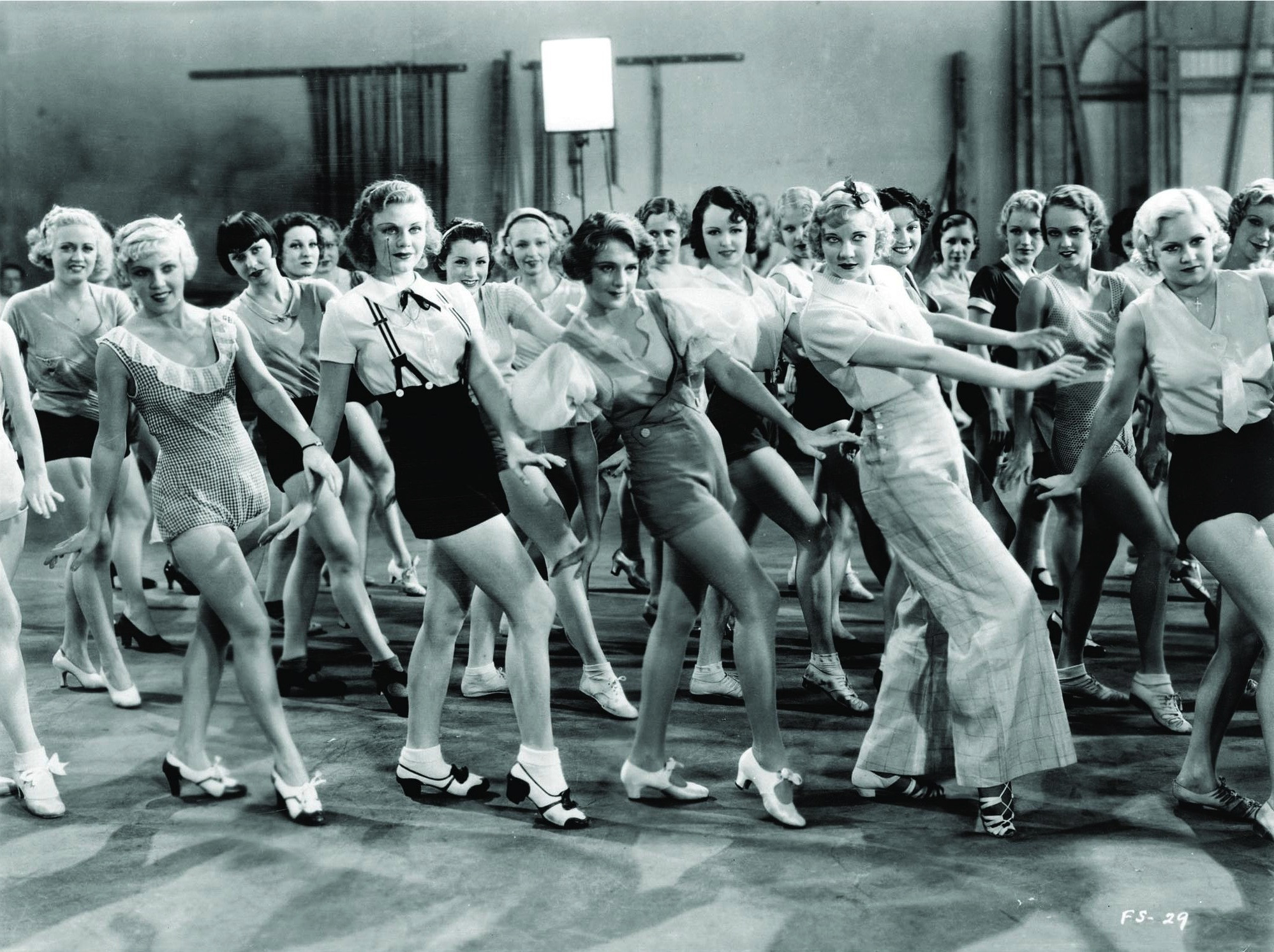“Jones and Barry are doing a show!”
“You’re telling me?”
 Scene from 42nd Street showcasing the bustling energy of the backstage world, highlighting the film's depiction of a vibrant 'dance street' environment within the theater.
Scene from 42nd Street showcasing the bustling energy of the backstage world, highlighting the film's depiction of a vibrant 'dance street' environment within the theater.
My initial encounter with 42nd Street (1933, directed by Lloyd Bacon) was underwhelming. Despite captivating stills and a title that resonated with the allure of urban grit and glamour, the film, excluding its iconic finale, left me indifferent. Renting it from Montreal’s National Library in my youth, I recall a sense of disappointment. While not disliked, it simply felt like another film in the vast cinematic landscape. This lukewarm opinion persisted for years until a DVD box set, primarily acquired for DAMES, prompted a second viewing of 42nd Street. This time, something shifted. The film’s magic took hold, and I fell completely in love. Perhaps it was maturity or a deeper appreciation for the pre-code era’s cinematic boldness, but 42nd Street transformed into a beloved favorite. It even earned a spot on my top 40 films list, a testament to its enduring appeal and my evolved perception of its brilliance as a quintessential Dance Street Film.
 Promotional poster for 42nd Street featuring the star cast and highlighting the film's Broadway setting, key aspects of a 'dance street film'.
Promotional poster for 42nd Street featuring the star cast and highlighting the film's Broadway setting, key aspects of a 'dance street film'.
Previously, I touched upon 42nd Street in an article spotlighting my favorite Busby Berkeley dance numbers. Today, I revisit this cinematic gem as part of Rebecca from Taking Up Room‘s Broadway Bound Blogathon, now in its 7th edition! The blogathon explores various facets of the Broadway-Hollywood connection, including films by Broadway-Hollywood figures, Broadway biopics, movies about Broadway, Broadway show adaptations into film, and films adapted into Broadway shows.
 Banner for the 7th Broadway Bound Blogathon, visually linking Broadway and Hollywood, relevant to the discussion of 42nd Street as a film and stage production.
Banner for the 7th Broadway Bound Blogathon, visually linking Broadway and Hollywood, relevant to the discussion of 42nd Street as a film and stage production.
42nd Street perfectly embodies the transformation from film to Broadway musical. Intriguingly, this quintessential Broadway story began on the silver screen. Adding to the allure, I experienced the stage adaptation at London’s Royal Drury Lane in 2018, featuring the legendary Lulu as Miss Dorothy Brock (a role originated by Bebe Daniels in the film). It was, unequivocally, one of the most captivating shows I’ve ever witnessed. But more on that later.
Before gracing the silver screen, 42nd Street originated as a novel by Bradford Ropes. Rian James and James Seymour (uncredited) adapted the novel for the screenplay, Lloyd Bacon directed, Harry Warren composed the unforgettable music, Al Dubin penned the lyrics, and Busby Berkeley orchestrated his signature, mind-bending choreographies.
What narrative unfolds in 42nd Street? Set against the backdrop of the Great Depression, a common setting for Busby Berkeley musicals, the film introduces us to Pretty Lady, a show produced by Jones and Barry. Acclaimed director Julian Marsh (Warner Baxter) and celebrated actress Dorothy Brock (Bebe Daniels) helm the production. However, the path to opening night is fraught with challenges. Marsh, under immense pressure to deliver a hit amidst the economic crisis, pushes himself and his company relentlessly, ignoring doctor’s orders to rest. Dorothy Brock’s involvement is financially secured by her wealthy admirer, Abner Dillon (Guy Kibbee), while she secretly engages in a love affair with vaudeville actor Pat Denning (George Brent), a precarious situation if revealed to the production, particularly Dillon.
 Still from 42nd Street featuring Warner Baxter as Julian Marsh, capturing the intensity and pressure of directing a Broadway show, a central theme of the 'dance street film'.
Still from 42nd Street featuring Warner Baxter as Julian Marsh, capturing the intensity and pressure of directing a Broadway show, a central theme of the 'dance street film'.
 Promotional image of Bebe Daniels as Dorothy Brock and George Brent as Pat Denning, highlighting the romantic subplot within the backstage drama of 42nd Street.
Promotional image of Bebe Daniels as Dorothy Brock and George Brent as Pat Denning, highlighting the romantic subplot within the backstage drama of 42nd Street.
Meanwhile, the casting process introduces us to aspiring performers. Peggy Sawyer (Ruby Keeler), a fresh face, secures a spot through fortunate circumstances. While not a seasoned actress or singer, her tap-dancing talent shines. At auditions, she befriends Ann “Anytime Anny” Lowel (Ginger Rogers) and Lorraine Fleming (Una Merkel). Lorraine’s connections with dance director Andy Lee (George E. Stone) aid the trio in landing roles. Peggy also encounters the charming Billy Lawyer (Dick Powell), another cast member, during this pivotal audition day.
 Publicity shot of Ruby Keeler as Peggy Sawyer and Dick Powell as Billy Lawler, representing the youthful romance and ambition in the 'dance street film' narrative.
Publicity shot of Ruby Keeler as Peggy Sawyer and Dick Powell as Billy Lawler, representing the youthful romance and ambition in the 'dance street film' narrative.
Events unfold in unexpected ways, especially after Peggy and Pat’s paths cross.
But, as Freddie Mercury famously sang, “the show must go on.”
42nd Street stands as a remarkable production, particularly given its creation during a period of economic austerity. Its elaborate staging and musical sequences demonstrate exceptional creativity and fundamentally shaped the cinematic portrayal of Broadway shows. Unlike the fixed perspective of a stage performance, 42nd Street, through the artistry of cinematographer Sol Polito and editors Thomas Pratt and Frank Ware, immerses viewers within the musical numbers, offering multifaceted perspectives on Berkeley’s choreography. This cinematic advantage is unique to film, unattainable in live theater. With a budget of approximately $440,000 (around $10 million today), the film grossed $2.3 million (equivalent to $55.5 million today), a resounding and well-deserved success.
The cast is a blend of established and rising stars. Warner Baxter, Bebe Daniels, and George Brent, all prominent figures from the silent era, likely received top billing. Ruby Keeler made her film debut with 42nd Street, while Ginger Rogers had been in the industry since 1930. Dick Powell, also relatively new since 1932, was emerging. Una Merkel, despite a film career dating back to the early 1920s, was primarily known as a character actress in supporting roles. Interestingly, while Baxter, Daniels, and Brent were likely the biggest names at the time, their post-42nd Street careers, with the exception of Brent, didn’t achieve the same enduring recognition. Baxter’s later films are less remembered, and Daniels, despite a successful silent film career and 42nd Street marking a strong transition to talkies, remained active in film only until 1935. George Brent, however, saw his career flourish after 42nd Street, with notable roles in Jezebel, The Spiral Staircase, and Dark Victory, titles more familiar to contemporary classic film enthusiasts.
It’s crucial to acknowledge that the lesser-known contemporary fame of Daniels and Baxter doesn’t diminish their performances in 42nd Street. Quite the contrary. Warner Baxter delivers a compelling portrayal of a director consumed by pressure, convincingly conveying the exhaustion and intensity of his character without exaggeration. Bebe Daniels embodies the demanding diva Dorothy Brock, initially projecting self-assurance but gradually revealing vulnerability and emotional depth, particularly in a poignant scene with Peggy. Her character arc, alongside Ginger Rogers’s, is among the most compelling, showcasing a transformation towards understanding and agreeability.
 GIF of Bebe Daniels and George Brent in 42nd Street, emphasizing the romantic chemistry between their characters and the film's exploration of relationships amidst the theatrical setting.
GIF of Bebe Daniels and George Brent in 42nd Street, emphasizing the romantic chemistry between their characters and the film's exploration of relationships amidst the theatrical setting.
Dorothy’s softer side first emerges with George Brent’s Pat Denning, her lover. He understands her, fostering a relationship where she can shed her facade of toughness, revealing her genuine self. Brent’s performance is engaging, seamlessly integrating with the ensemble and sharing strong chemistry with Daniels. His character is charming, making Dorothy’s affection and Peggy’s friendship understandable. Peggy and Pat share a delightful camaraderie, more akin to close friends than potential lovers. Pat’s romantic interest in Peggy is evident, but she doesn’t reciprocate, a boundary he respects.
Peggy’s romantic focus lies elsewhere: Billy, portrayed by Dick Powell. 42nd Street marked their first on-screen pairing, launching them as an iconic 1930s musical duo. They starred in six more films together: Gold Diggers of 1933, Footlight Parade, Dames, Flirtation Walk, Shipmates Forever, and Colleen. Their on-screen chemistry was enchanting, embodying the quintessential boy-next-door and girl-next-door charm. While celebrated for musicals, neither were exceptional actors or singers, though Powell possessed a strong vocal presence. Powell’s dancing wasn’t a primary focus. Keeler, a capable tap dancer, lacked the grace of contemporaries like Eleanor Powell or Fred Astaire. Yet, their combined presence was essential to 42nd Street and the Busby Berkeley musicals they graced. Their appeal likely stemmed from embodying ordinary, relatable individuals, resonating deeply with Depression-era audiences.
Ginger Rogers and Una Merkel deserve further mention. Rogers, of this cast, ascended to superstardom. In 42nd Street, she plays a supporting role and, surprisingly, doesn’t dance extensively, despite dance being her hallmark. Her character, Ann, adopts a sophisticated persona, which her close friend Lorraine playfully mocks. Rogers and Merkel embody ideal female friendship, stealing scenes with their every appearance, making audiences wish to join their circle. Ann, despite her affected demeanor, performs a noble act late in the film, significantly impacting the narrative’s resolution.
42nd Street remains a pivotal musical of early Hollywood’s sound era for numerous reasons. It elevated the careers of its cast and, with Busby Berkeley’s groundbreaking choreography, solidified the musical genre’s prominence. While musical comedies existed prior, like 1929’s The Broadway Melody, the second film to win Best Picture Oscar, they lacked the sophisticated musicality that 42nd Street introduced. The Broadway Melody, despite its historical significance as the first all-talking, all-singing feature, repeated its title song excessively, and its musical numbers were less memorable. Though The Broadway Melody is personally enjoyable, primarily for Bessie Love’s performance, as a musical, it pales in comparison. However, it paved the way for the backstage musicals that gained popularity in the 1930s, culminating in the arrival of 42nd Street four years later.
Busby Berkeley had previous choreography credits, but 42nd Street cemented his reputation, allowing him to refine his technique of integrating dance into film. His dance sequences were characterized by remarkable precision, requiring dancers to move in perfect unison to create striking visual patterns, an aesthetic possibly influenced by his World War 1 military service. The film’s impact led Warner Brothers to offer Berkeley a long-term contract. Berkeley’s choreographies are the film’s centerpiece, predominantly featured in the grand finale, underscoring the culmination of effort and artistry. This final act’s musical numbers transport viewers to diverse visual realms. While the narrative of Pretty Lady remains abstract, the focus rightly shifts to the captivating choreography and songs. The music, while not the most instantly catchy, is memorable and complements Berkeley’s visual mastery. As a backstage musical, the songs aren’t primarily narrative drivers but serve as springboards for elaborate choreographic displays.
Each musical number is unique, showcasing varied filming techniques and elements. “Shuffle Off to Buffalo” unfolds on a train, filmed in a transversal cut, offering glimpses into passenger compartments. Initially showing the newlyweds (Keeler and Clarence Nordstrom) moving away from us on the rear car, the car then magically bisects, revealing an interior horizontal perspective.
“Young and Healthy,” sung by Dick Powell, perhaps best exemplifies Berkeley’s military precision and kaleidoscopic style. Utilizing kaleidoscopic effects, identically dressed dancers move in perfect synchronicity, forming geometric patterns. The film’s iconic poster image of aligned legs originates from this number. The camera glides beneath the dancers’ legs, culminating on Toby Wing and Dick Powell’s faces. The filming technique remains impressive even by contemporary standards, reminiscent of the aerial camera work in Wings.
The finale, “42nd Street,” is grand in scale, surpassing stage limitations. Evoking New York’s 42nd Street, it feels as if the city itself is on stage. Beginning with Ruby Keeler’s solo dance and song, the scene explodes into a bustling cityscape as she departs in a cab. The striking moment featuring real cars beneath a bridge (possibly Brooklyn or Manhattan Bridge), with engine smoke rising, is a cinematic feat impossible to replicate on stage – the magic of film.
The musical numbers are enhanced by Jack Oakey’s understated set design and Orry-Kelly’s elegant costumes, adding sophistication to the precision choreography. Warner Bros., simultaneously producing gritty gangster films and these visually opulent musicals, found its stars for each genre: Ginger Rogers and James Cagney. While MGM dominated Technicolor musicals like The Wizard of Oz, Oklahoma!, Meet Me in St. Louis, and Singin’ in the Rain, Warner Bros. excelled in black and white musical splendor.
42nd Street was a box office sensation, rescuing Warner Bros. from potential bankruptcy upon its premiere on March 9, 1933, at New York’s Strand Theatre. Critics lauded its technical achievements and vibrant musical numbers, though acknowledging the conventional plot. At the Oscars, it received Best Picture and Best Sound Recording nominations. Today, its quality endures, holding a 96% rating on Rotten Tomatoes.
42nd Street‘s legacy is undeniable, inspiring a successful stage musical. Having seen it in London, the stage adaptation was a captivating experience. Remarkably, I secured discounted tickets for premium seats. Developed in the 1980s, the 42nd Street musical, like Phantom of the Opera, became a long-running classic. Expanding beyond the film’s score, the stage version incorporated songs from other musical films of the era, including “We’re in the Money” from Gold Diggers of 1933, enriching the plot and ensuring a consistently engaging experience. It was a highlight of my London trip.
The stage production ingeniously recreated Busby Berkeley’s kaleidoscopic effects using dancers on the floor reflected in a giant mirror, approximating the cinematic visuals, albeit less precisely. The overall effect was exhilarating. The musical garnered Tony nominations, winning Best Musical and Best Choreography, well-deserved accolades recognizing the central role of dance in 42nd Street.
42nd Street is a film deserving of repeated viewings and multifaceted analysis. Having witnessed its stage incarnation, I eagerly anticipate experiencing the film version on the big screen, particularly for its musical sequences. Even those who typically dislike musicals might find 42nd Street appealing, as music is strategically employed to enhance, rather than dominate, the narrative, creating an unforgettable cinematic experience.
Many thanks to Rebecca for hosting this blogathon! Explore all entries here.
See you!
Enjoy this blog’s content? Consider supporting The Wonderful World of Cinema!
Sources
Share this:
- Click to share on Twitter (Opens in new window)
- Click to share on Facebook (Opens in new window)
Like Loading…


